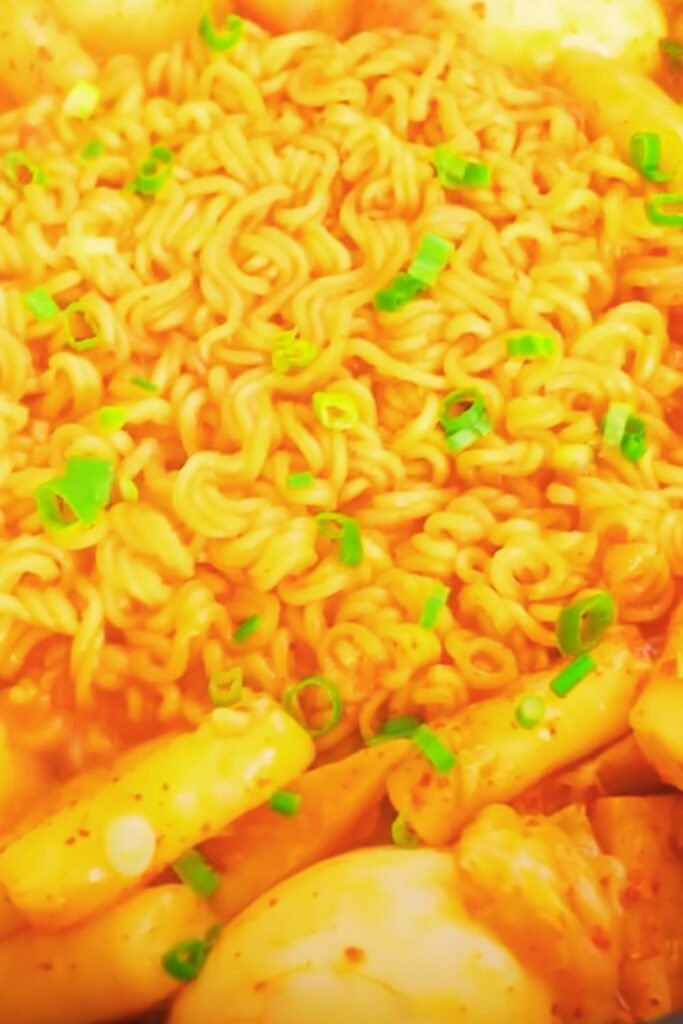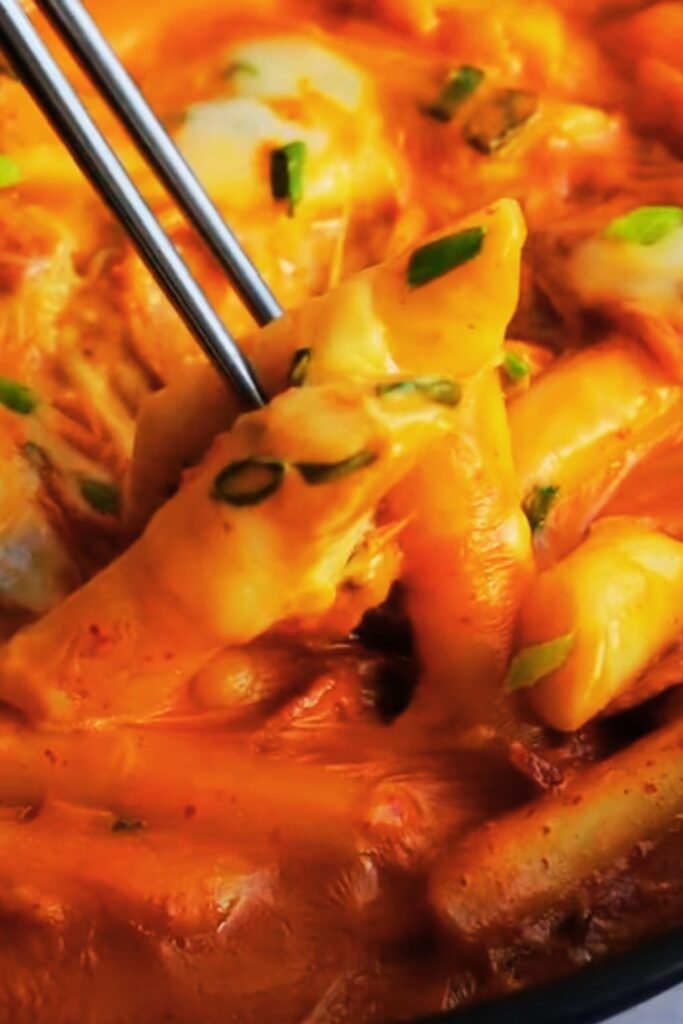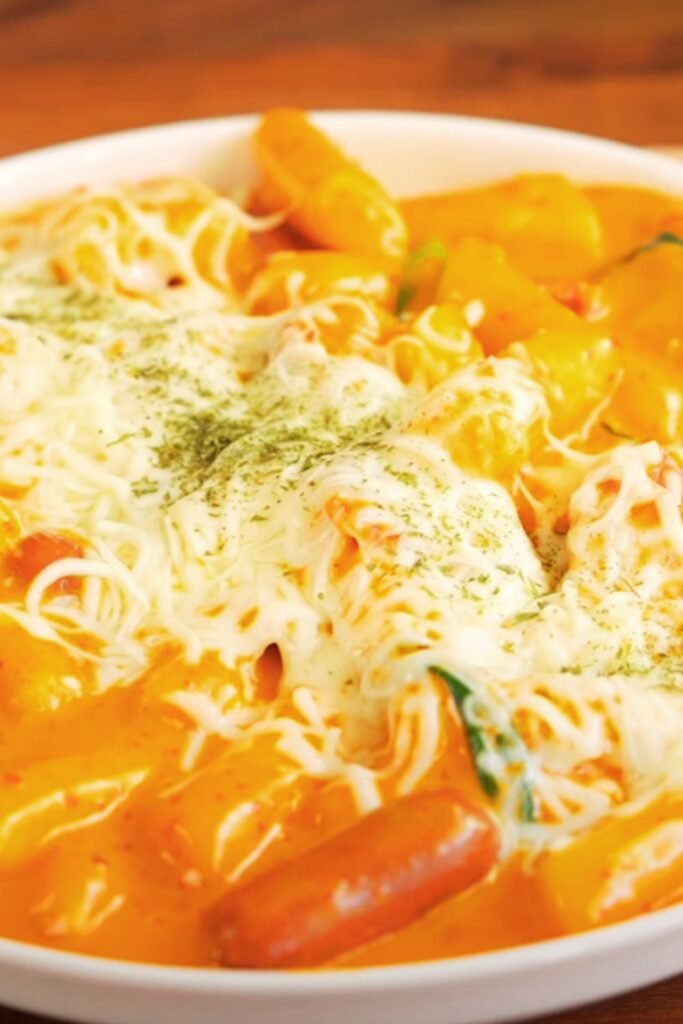I never imagined that combining Korean street food with cream cheese would become one of my favorite culinary discoveries. Rose tteokbokki, or “로제떡볶이” in Korean, has completely transformed my understanding of traditional Korean rice cakes. This fusion dish brings together the spicy, chewy satisfaction of classic tteokbokki with the creamy richness that makes every bite absolutely irresistible.
When I first encountered rose tteokbokki at a trendy Korean restaurant in Seoul, I was skeptical. The pink-hued sauce looked almost too pretty to be the fiery Korean dish I knew and loved. But one bite changed everything. The cream cheese didn’t mask the gochujang’s heat – instead, it created this beautiful balance that made me want to recreate it in my own kitchen immediately.
Understanding Rose Tteokbokki: A Modern Korean Innovation
Rose Tteokbokki is a contemporary twist on the beloved Korean street food tteokbokki, where traditional spicy rice cakes meet Western dairy elements, primarily cream cheese and sometimes heavy cream. The “rose” designation comes from the distinctive pink color created when cream cheese blends with the red gochujang base sauce.
Tteok refers to Korean rice cakes, specifically the cylindrical, chewy variety called garaetteok used in this dish. These rice cakes have a uniquely satisfying texture that’s simultaneously soft and chewy.
Gochujang is fermented Korean chili paste that provides the foundational heat and umami depth. It’s less aggressive than pure chili powder and offers complex flavors from fermentation.
Fusion Element represents the cream cheese addition that transforms traditional tteokbokki into this modern comfort food phenomenon that’s taken Korean cuisine by storm.
The dish emerged from Korea’s growing cafe culture and represents how traditional recipes evolve to meet contemporary tastes while maintaining their cultural identity.
My Rose Tteokbokki Recipe: Perfected Through Trial and Error
After countless attempts in my kitchen, I’ve developed what I consider the perfect rose tteokbokki recipe. The key lies in balancing the heat with creaminess while maintaining that essential chewy texture that makes tteokbokki so addictive.
Essential Ingredients for Authentic Rose Tteokbokki
| Ingredient | Quantity | Purpose | Substitution Notes |
|---|---|---|---|
| Fresh rice cakes (garaetteok) | 500g | Main component | Frozen works, but soak longer |
| Cream cheese | 150g | Creates rose color and creaminess | Philadelphia or Korean brands preferred |
| Gochujang | 3 tablespoons | Heat and base flavor | Adjust to taste preference |
| Heavy cream | 100ml | Additional richness | Can reduce for lighter version |
| Korean fish cake | 100g | Traditional protein element | Omit for vegetarian version |
| Green onions | 3 stalks | Fresh finish | Regular scallions work fine |
| Garlic | 4 cloves | Aromatic base | Garlic powder in pinch |
| Soy sauce | 2 tablespoons | Umami depth | Low-sodium preferred |
| Sugar | 1 tablespoon | Balances heat | Honey works as alternative |
| Sesame oil | 1 teaspoon | Nutty finish | Don’t skip this element |
| Water or anchovy stock | 300ml | Cooking liquid | Stock adds more depth |
Step-by-Step Preparation Method
I’ve refined this process through numerous cooking sessions, and each step contributes to the final result’s success.
Preparation Phase:
- Soak rice cakes in warm water for 30 minutes if using refrigerated ones
- Cut fish cake into bite-sized triangular pieces
- Mince garlic finely to release maximum flavor
- Chop green onions, separating white and green parts
- Have cream cheese at room temperature for easier melting
Cooking Process:
- Create the Base Sauce Heat a large pan over medium heat and add minced garlic. Cook for 30 seconds until fragrant, being careful not to burn it.
- Build the Flavor Foundation Add gochujang to the pan and stir constantly for 1 minute. This step is crucial as it develops the paste’s flavors and removes any raw taste.
- Add Liquid Elements Pour in water or anchovy stock gradually while stirring. Add soy sauce and sugar, mixing until the sugar completely dissolves.
- Incorporate Rice Cakes Drain the soaked rice cakes and add them to the bubbling sauce. Cook for 5-7 minutes, stirring occasionally to prevent sticking.
- Add Protein Elements Include fish cake pieces and cook for another 3 minutes until they’re heated through and have absorbed some sauce.
- Create the Rose Effect Lower the heat and gradually add cream cheese in small pieces, stirring constantly until it melts completely and creates that signature pink color.
- Final Richness Pour in heavy cream and stir gently. The sauce should become glossy and coat the rice cakes beautifully.
- Finishing Touches Add white parts of green onions and cook for 1 minute. Drizzle with sesame oil and garnish with green onion tops.

Mastering the Perfect Texture and Consistency
The magic of rose tteokbokki lies not just in its flavor but in achieving that perfect texture combination. I’ve learned that timing is everything when it comes to rice cake preparation.
Fresh rice cakes require minimal soaking, while frozen ones need at least 30 minutes in warm water. I always test a piece before cooking – it should yield slightly to pressure but still maintain its shape. Oversoaked rice cakes become mushy and lose that characteristic chewiness that makes tteokbokki so satisfying.
The sauce consistency requires careful attention. I aim for a coating that clings to the rice cakes without being too thick or too thin. If my sauce becomes too thick, I add small amounts of hot water. If it’s too thin, I simmer it uncovered for a few extra minutes to reduce it.
Temperature control is crucial when adding cream cheese. Too high heat causes the dairy to separate and creates an unappetizing grainy texture. I always reduce to low heat before incorporating any dairy elements, stirring constantly to ensure smooth integration.
Nutritional Profile and Dietary Considerations
Understanding the nutritional aspects of rose tteokbokki helps me make informed decisions about portion sizes and frequency of enjoyment.
Detailed Nutritional Breakdown
| Component | Per Serving (1/4 recipe) | Daily Value % | Health Notes |
|---|---|---|---|
| Calories | 485 | 24% | High energy content |
| Carbohydrates | 68g | 23% | Primarily from rice cakes |
| Protein | 12g | 24% | From cream cheese and fish cake |
| Fat | 18g | 23% | Mainly saturated from dairy |
| Sodium | 1,240mg | 54% | High due to gochujang and soy sauce |
| Fiber | 2g | 7% | Limited fiber content |
| Calcium | 185mg | 14% | From cream cheese |
| Iron | 2.1mg | 12% | From gochujang and rice cakes |
Dietary Modifications I’ve Successfully Tested
Lower Sodium Version: I reduce soy sauce by half and use low-sodium gochujang when available. This cuts sodium by approximately 25% without significantly impacting flavor.
Vegetarian Adaptation: Eliminating fish cake and using vegetable stock instead of anchovy stock creates a vegetarian-friendly version that loses none of the essential character.
Dairy-Free Alternative: While it changes the fundamental nature of “rose” tteokbokki, I’ve successfully used cashew cream and nutritional yeast to create a creamy texture without dairy products.
Reduced Calorie Version: Using light cream cheese and reducing heavy cream by half cuts calories by approximately 150 per serving while maintaining satisfying creaminess.
Cultural Significance and Modern Evolution
Rose tteokbokki represents a fascinating intersection of traditional Korean cuisine and contemporary fusion cooking. When I researched its origins, I discovered it emerged from Korea’s vibrant cafe culture in the early 2010s, particularly in areas like Hongdae and Gangnam where young Koreans experiment with traditional foods.
Traditional tteokbokki dates back to the Joseon Dynasty, though the modern spicy version only appeared in the 1950s when gochujang became widely available. The addition of cream cheese reflects Korea’s increasing openness to Western ingredients while maintaining cultural food identity.
I find it remarkable how this dish maintains its Korean soul despite the Western influence. The gochujang still provides the primary flavor profile, and the rice cakes remain the textural star. The cream cheese enhances rather than overwhelms, creating something new while respecting the original.

Regional Variations and Personal Adaptations
During my travels throughout Korea, I’ve encountered numerous regional interpretations of rose tteokbokki, each reflecting local preferences and available ingredients.
Seoul Style: Often includes mozzarella cheese in addition to cream cheese, creating extra stretch and richness. Some vendors add a touch of milk for additional creaminess.
Busan Variation: Incorporates seafood elements like small shrimp or squid pieces, reflecting the coastal city’s maritime culture.
Jeju Island Version: Features local mushrooms and sometimes includes a hint of citrus from Jeju’s famous oranges.
My Personal Adaptations:
I’ve developed several variations based on seasonal ingredients and personal preferences:
- Autumn Version: Adds roasted butternut squash pieces for sweetness and additional texture
- Protein-Rich: Includes soft-boiled eggs and extra fish cake for a more substantial meal
- Vegetable-Forward: Incorporates mushrooms, bell peppers, and zucchini for additional nutrients and colors
- Spicy Lover’s: Doubles the gochujang and adds fresh sliced jalapeños for extra heat
Serving Suggestions and Presentation Ideas
Presentation plays a crucial role in the rose tteokbokki experience. The visual appeal of that beautiful pink sauce deserves proper showcasing.
Traditional Korean Serving:
- Serve in individual stone bowls (dolsot) to maintain temperature
- Provide wooden chopsticks and small spoons
- Include pickled radish (danmuji) as a palate cleanser
- Offer small dishes of additional gochujang for heat lovers
Modern Presentation Options:
- Cast iron skillets for dramatic table presentation
- Individual ramekins for controlled portions
- Large sharing plates with multiple chopstick sets for family-style dining
Complementary Side Dishes:
- Kimchi: The fermented tanginess cuts through the richness
- Korean Pickled Vegetables: Provide acidic contrast to the creamy sauce
- Seaweed Soup: Light and refreshing balance to the heavy dish
- Korean Fried Chicken: For those wanting a complete Korean comfort food experience
- Fresh Lettuce Wraps: Allow diners to create their own wrapped portions
Garnish Ideas I’ve Perfected:
- Sesame seeds for nutty crunch
- Thin julienned nori sheets for oceanic flavor
- Sliced fresh chili peppers for color and heat
- Crispy fried garlic for textural contrast
Storage, Reheating, and Make-Ahead Tips
Rose tteokbokki is definitely best enjoyed fresh, but I’ve developed reliable methods for storage and reheating that maintain quality.
Storage Guidelines:
- Refrigerate leftovers within 2 hours of cooking
- Store in airtight containers for maximum 3 days
- Don’t freeze completed dish as cream cheese separation occurs
Reheating Techniques:
- Stovetop Method: My preferred approach involves adding 2-3 tablespoons of water and reheating over low heat, stirring frequently
- Microwave Option: Heat in 30-second intervals, stirring between, until heated through
- Oven Method: Cover with foil and reheat at 300°F for 10-15 minutes
Make-Ahead Strategies:
- Prepare sauce base without dairy components up to 2 days ahead
- Soak rice cakes and refrigerate overnight
- Add cream cheese and cream only when ready to serve for optimal texture

Troubleshooting Common Issues
Through my numerous attempts at perfecting rose tteokbokki, I’ve encountered and solved various common problems that home cooks face.
Problem: Sauce Too Thick or Thin Solution: For thick sauce, gradually add hot water while stirring. For thin sauce, simmer uncovered to reduce, or mix 1 tablespoon cornstarch with cold water and stir in.
Problem: Cream Cheese Won’t Incorporate Smoothly Solution: Ensure cream cheese reaches room temperature before use. Always reduce heat to low before adding dairy. Add in small pieces while stirring constantly.
Problem: Rice Cakes Become Mushy Solution: Don’t oversoak rice cakes. Test texture before cooking. Avoid overcooking once in sauce.
Problem: Dish Too Spicy or Not Spicy Enough Solution: For too spicy, add more cream cheese or a touch of honey. For not spicy enough, add gochujang gradually or include fresh chili slices.
Problem: Sauce Separates or Looks Grainy Solution: This indicates overheating. Remove from heat immediately and whisk vigorously. If necessary, add a splash of cold cream while whisking.
Q&A Section
Q: Can I make rose tteokbokki without cream cheese? A: While cream cheese is essential for the “rose” color and creamy texture, you can substitute with mascarpone or even thick Greek yogurt mixed with a little milk. However, this changes the fundamental character of the dish significantly.
Q: How spicy is rose tteokbokki compared to traditional tteokbokki? A: Rose tteokbokki is generally milder than traditional versions because the cream cheese mellows the heat from gochujang. I’d rate traditional tteokbokki at a 7/10 for spice level, while rose version sits around 4-5/10.
Q: Can I use instant rice cakes from the package? A: Yes, but fresh or refrigerated rice cakes provide superior texture. If using dried instant rice cakes, soak them longer and expect a slightly different chewiness.
Q: Is rose tteokbokki suitable for meal prep? A: While possible, I don’t recommend it as the rice cakes can become mushy and the cream sauce may separate. It’s best enjoyed fresh, though leftovers can be successfully reheated using proper techniques.
Q: What’s the best substitute for gochujang if I can’t find it? A: Mix sriracha with miso paste and a touch of brown sugar, though this won’t perfectly replicate gochujang’s complex fermented flavors. Korean grocery stores or online retailers are your best sources for authentic gochujang.
Q: Can I make this dish vegan? A: You can create a vegan version using cashew cream or vegan cream cheese alternatives, but it won’t be traditional “rose” tteokbokki. The result will be delicious but fundamentally different in character.
Q: How do I prevent the rice cakes from sticking to the pan? A: Use adequate oil or cooking spray, maintain medium heat, and stir regularly. Adding liquid early in the cooking process also helps prevent sticking.
Q: Can I add other vegetables to rose tteokbokki? A: Absolutely! I often add mushrooms, bell peppers, or onions. Add harder vegetables early in the cooking process and softer ones near the end to maintain proper textures.
Q: Why does my rose tteokbokki look more orange than pink? A: This usually indicates insufficient cream cheese or too much gochujang. Adjust the ratio by adding more cream cheese gradually until you achieve the desired pink color.
Q: How long can I keep leftover rose tteokbokki? A: Properly stored in the refrigerator, leftovers remain safe for 3 days maximum. The texture deteriorates after the first day, but proper reheating techniques can restore much of the original appeal.
Rose tteokbokki has become more than just a recipe in my kitchen – it’s a bridge between cultures and a testament to how traditional foods can evolve while maintaining their essential character. Every time I prepare this dish, I’m reminded of how food brings people together, whether you’re enjoying it from a Seoul street vendor or making it in your own home kitchen thousands of miles away.